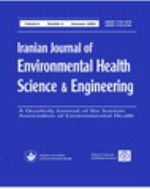
|
Iranian Journal of Environmental Health, Science and Engineering
Iranian Association of Environmental Health (IAEH)
ISSN: 1735-1979
Vol. 7, No. 3, 2010, pp. 327-336
|
 Bioline Code: se10038
Bioline Code: se10038
Full paper language: English
Document type: Research Article
Document available free of charge
|
|
|
Iranian Journal of Environmental Health, Science and Engineering, Vol. 7, No. 3, 2010, pp. 327-336
| en |
Performance Of Aerated Submerged Fixed-Film Bioreactor For Treatment Of Acrylonitrile-Containing Wastewater
Shakerkhatibi, M.; Ganjidoust, H.; Ayati, B. & Fatehifar, E.
Abstract
Acrylonitrile is used as the main raw material for manufacturing acrylonitrile butadiene styrene resin. It is usually found as pollutant in the petrochemical wastewater. In this research an aerated submerged fixed-film reactor was developed to treat a synthetic acrylonitrile butadiene styrene unit wastewater containing acrylonitrile. Laboratory experiments were conducted using a bioreactor with 44.2 L capacity operated at different hydraulic and organic loading rates. Stationary submerged biofilms were attached to net-type media (polypropylene) under diffused aeration. The specific surface area and porosity of media were 324 m2/m3 and 87%, respectively. In the first phase the reactor was operated in hydraulic retention times of 9, 7, 5 and 4 h with soluble chemical oxygen demand of 300 mg/L. Then the experiments were continued with the constant retention time of 4 h and variable chemical oxygen demand concentrations of 350, 400 and 450 mg/L. In stable condition of operation and loading rates of 0.8 to 2.4 kg/m3d the removal efficiencies of reactor for soluble chemical oxygen demand reached to 95 to 99%. At the organic loading rate up to 2.4 kg/m3d the soluble chemical oxygen demand was less than 50 mg/L which was lower than the Iranian national discharge standards (chemical oxygen demand>60 mg/L). The increase of organic and surface loading to 2.7 kg/m3d and 23.16 g/m2d, respectively, caused the system becoming unstable and the soluble chemical oxygen demand removal efficiency decreased to 66%. Finally, the kinetic coefficients of the aerated submerged fixed-film reactor for treating of acrylonitrile were determined using a separate pilot unit. According to the results, it was concluded that the aerated submerged fixed-film reactor can be used as suitable approaches for treating of petrochemical effluents contain acrylonitrile.
Keywords
Acrylonitrile; acrylonitrile butadiene styrene resins; Aerated submerged fixed-film reactor; Petrochemical wastewater; Biological treatment
|
| |
© Copyright 2010 Iran Journal of EnvironHealth Sci Eng.
Alternative site location: http://diglib.tums.ac.ir/pub/
|
|
